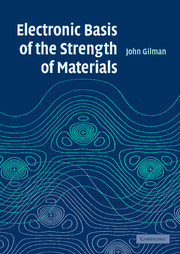Book contents
- Frontmatter
- Contents
- Preface
- Section I Introduction
- Section II Elements of solid mechanics
- Section III Elements of electron mechanics
- Section IV Elastic stiffness
- 9 Cohesion of atoms
- 10 Intramolecular cohesion
- 11 Intermolecular cohesion
- 12 Bulk modulus
- 13 Shear modulus
- 14 Entropic elasticity (polymers)
- 15 Universality and unification
- Section V Plastic strength
- Section VI Fracture resistance
- Index
- References
12 - Bulk modulus
Published online by Cambridge University Press: 14 August 2009
- Frontmatter
- Contents
- Preface
- Section I Introduction
- Section II Elements of solid mechanics
- Section III Elements of electron mechanics
- Section IV Elastic stiffness
- 9 Cohesion of atoms
- 10 Intramolecular cohesion
- 11 Intermolecular cohesion
- 12 Bulk modulus
- 13 Shear modulus
- 14 Entropic elasticity (polymers)
- 15 Universality and unification
- Section V Plastic strength
- Section VI Fracture resistance
- Index
- References
Summary
Having considered the cohesion within atoms and molecules, and between atoms and molecules, we are in a position to consider the factors that determine the magnitudes of the elastic coefficients connecting stresses and strains. We wish to see how these coefficients are related to the electronic structures, that is, to chemical factors.
The elastic response coefficients are the most fundamental of all of the properties of solids; and the most important sub-set of them is the shear coefficients because they determine the existence of the solid state. If the shear stiffnesses were not sufficiently large, all matter would be liquid like. There would be no aeronautical, civil, or mechanical engineering; and modern micro-electronics, as well as opto-electronics would not be possible. They set limits on how strong materials can be, how slowly geological processes occur, and how natural structures respond to wind and rain. This is why the scientific study of them which began with Galileo (the founder of physical mechanics) continues today. However, the shear moduli are considerably more difficult to interpret in detail than the bulk moduli. They depend on both the shear plane, and the shear direction; and the structures of both of these depend on crystal symmetries and local atomic structures. The bulk modulus, on the other hand, is a scalar quantity relating an isotropic pressure to an average change in volume. It is the average of the three inverse linear compressibilities (change of length induced by pressure).
- Type
- Chapter
- Information
- Electronic Basis of the Strength of Materials , pp. 110 - 141Publisher: Cambridge University PressPrint publication year: 2003



